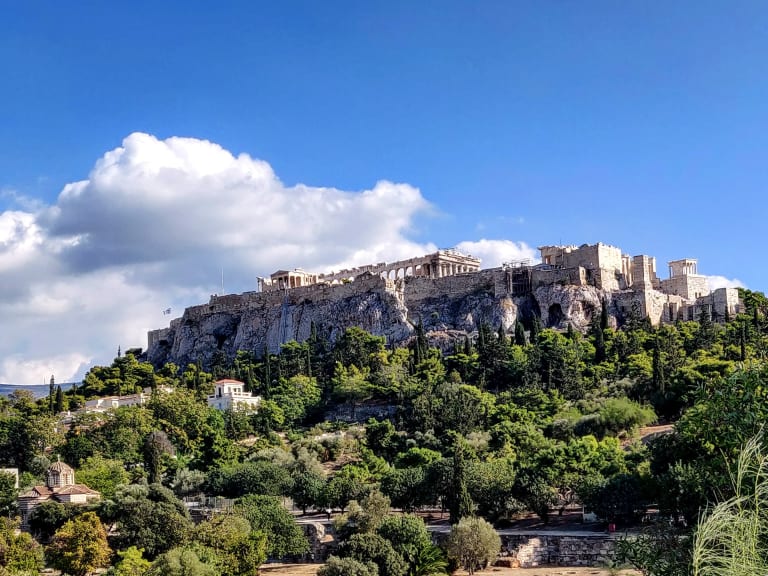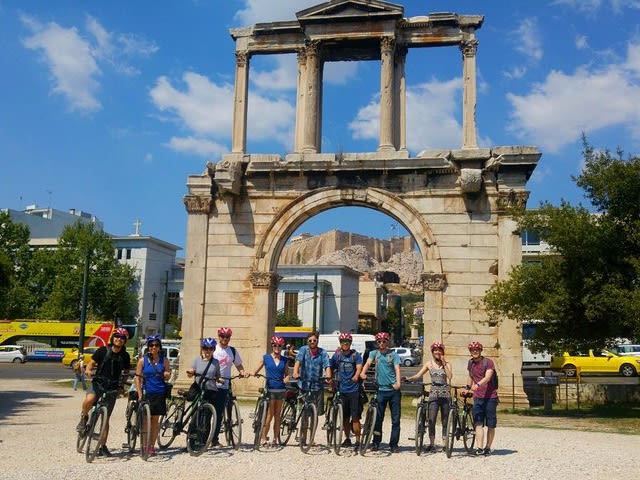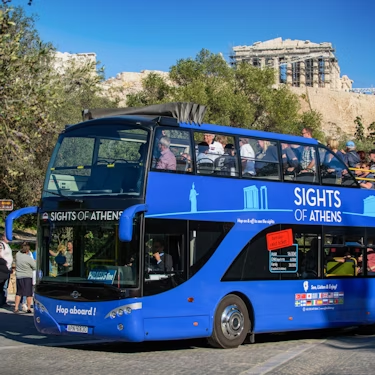More about: Best Things to Do In Athens In 2 Days
Touring Athens in 2 days can be a very fun and interesting way to learn or deepen your knowledge of Ancient Mediterranean history. The only problem is that the sheer amount of things to see and do in Athens makes it essential to organize your itinerary well to get the most out of your trip.
Athens is an ideal place to explore on foot or by public transport, as it is home to many archaeological sites, museums and monuments that show why this city is considered the cradle of civilization.
Day 1: See the splendor of the Acropolis, the Temple of Zeus, the Agora, watch the sunset from the Mount and have dinner in Kolonaki

The first day in the Greek capital can have no other protagonist than the Acropolis and its impressive Parthenon.
The rest of the day will not be short of cultural and historical attractions that will make you feel as if you were walking through classical Greece.
To get to know it you can do it on your own or hire one of the organized tours of Athens, which have the presence of a guide who will explain its history and secrets.
Visit the Acropolis
It is likely that the Acropolis and, especially, the Parthenon are the most emblematic places in Athens, so it is almost mandatory that you go to visit it.
This is because most of the temples, monuments and statues were built in the 5th century BC during the "Golden Age" of Pericles.
As its name indicates, the Acropolis (Akro: Top, Polis: City) is located on one of the highest points of Athens, so if you want to walk there, keep in mind that you will always be going uphill.
As time is money, I recommend you to get the Acropolis ticket in advance, as this way you will avoid waiting in line at the entrance under the sun's rays. Also, if you take the online option, keep in mind that you can also use the combined ticket to enter other sites of interest
- Opening hours: from April to October from 8 a.m. to 8 p.m. (The last entrance is at 7.30 p.m.). From November to May the opening hours are from 8 am to 5 pm. The Acropolis is open all year round except January 1st, March 25th, May 1st, Easter Sunday, December 25th and 26th
- Low season prices: From November to March the price is approximately 15 euros. This price also applies to persons over 65 years of age residing in the EU and students who do not belong to the European Union
- High season prices: From March to October the entrance fee is approximately 30 euros.
- How to get there: The most comfortable way to get there is to take the metro to Monastiraki station, on line 1 and 3. Once you get off, you can walk through the beautiful neighborhood of Plaka, which has many activities to offer or through the ancient Agora. I do not recommend you to go by car, as the place does not have an official parking lot and Athens traffic is usually quite complicated
- Duration of the visit: Normally, it will take you between 2 and 3 hours to do the whole tour, so this activity will allow you to connect this walk with others. The best time to visit is either early in the morning or during the afternoon, as the midday sun can be quite strong and the site lacks shaded areas.
Visit the Temple of Zeus
Just 500 meters from the Acropolis, the Temple of Zeus is another archaeological site that I recommend you visit.
Although its construction began in the 6th century BC, it was only completed in 132 AD, under the orders of Emperor Hadrian.
Like the Parthenon, this temple was built with marble from Mount Pentelicus and its size was colossal: it had more than 104 columns over 16 meters high. Today only 15 are still standing, as in the Middle Ages the temple was destroyed by an earthquake, but they will give you an idea of the size of the temple.
Please note that the visiting hours of the Temple of Zeus are between 8 am and 3 pm, so you will not be able to see the ruins during the afternoon.
If you visit Athens in summer or spring, I recommend that you visit early in the morning, as you will have less exposure to the sun and avoid the crowds that concentrate after noon.
- Hours: Open every day from 8 am to 3 pm, except January 1st, March 25th, May 1st, Easter Sunday, December 25th and 26th.
- Prices: You can buy tickets at the ticket office located at the entrance or on-line. Admission for adults over 25 years old is 15 euros and 6 euros for students.
- How to get there: From the Acropolis you only have to walk less than 10 minutes.
Travel back in time by visiting the Roman Agora and the Ancient Agora

Another key point to learn more about the history and tour the buildings of Classical Greece is to visit the Roman Agora and the Ancient Agora.
Located just a 20-minute walk from the temple, the Agora was the center of ancient Greek society, a place where the social, political and economic life of the polis was concentrated.
The ancient Agora was created in the 6th century B.C., this means that you can walk through places that were built more than 2500 years ago.
In this place the Temple of Hephaestus stands out, which is considered the best preserved Greek temple of today. I also recommend you to visit the Stoa of Attalos, where the museum of the Ancient Agora is located.
The entrance to the Roman Agora is almost next to the Ancient Agora, a mere 300 meters walk away. It is an impressive place, as you will be able to see the Gate of Athena Arquegetis and the Tower of the Winds.
- Opening hours: The Roman Agora is open daily from 8 am to 5 pm, while the Ancient Agora is from 8 am to 8 pm, although 30 minutes before closing time tourists are asked to go to the exit
- Prices: Each ticket is €10 for adults and €6 for students. I recommend you to get a combined ticket, since not only can you enter both Agoras for 30 euros, but also includes entry to the Acropolis and the Temple of Olympian Zeus.
Enjoy the sunset from Mount Lycabettus
Although it is somewhat distant from the previous point, it is worth approaching Mount Lycabettus when evening begins to fall.
Located in the south of Athens and about 290 meters above sea level, it is one of the best places to observe the beautiful panoramic view of the city of Athens, but above all a perfect view to contemplate the beauty of the Acropolis.
The mount is located in one of the most exclusive and elegant neighborhoods of Athens: Kolonaki. The name Lycabettus is due to the fact that in ancient times the mountain was a place where wolves abounded.
I recommend that you visit it at sunset, as the last rays of the sun are reflected by the marble of the Acropolis buildings. Also, if you decide to climb the mountain on foot, in summer it can be less overwhelming to do so in the late afternoon.
At the top you can find small stalls where you can eat or drink while waiting for the sunset. You can also visit the small Chapel of Agios Georgios, which at night is like a small lighthouse that illuminates the mountain.
- How to get there The summit can be reached by funicular or cable car, which costs about 8 euros and leaves every 30 minutes, from 9 am to midnight. This option is ideal if you are tired after a long day of hiking. You can also get there by car or on foot.
- How long it takes to go up The funicular will take you no more than 15 minutes, about the same as if you take a cab. On foot it is not too long either, since it is not a complicated climb, it will take you about 30 minutes, although this depends on each person.
End the day shopping or dining at Kolonaki
Down from the hill, just over 15 minutes away, you will find what is considered by many Athenians as the most elegant and luxurious neighborhood of the city.
It is a perfect place to taste the incredible Greek gastronomy or why not, indulge yourself a little by strolling through its exclusive clothing stores.
Its best known point is the Platia Filikis Eterias, its main square. This is surrounded by cafes, bars and exclusive restaurants, perfect for a first class dinner.
Of course, I advise that if you have the option to return to the Greek capital with more time, be sure to hire a gastronomic tour of Athens.
Day 2: From the Theater of Dionysus to the Archaeological Museum, with a tour ending with dinner in Piraeus

Athens has everything, so it is important that you get up early to make the most of the hours of the second day of your trip, as it will be quite complete.
One option is to study the tours offered by the tourist bus of Athens or the bike tours around the city for your can save time in the displacement.
Visit the Theater of Dionysus
If you like theater, art history, or music, you cannot miss this place full of history and culture of Ancient Greece. This open-air amphitheater was created more than 2500 years ago, and was used to celebrate in honor of Dionysus, the god of wine and theater.
Moreover, the dimensions of this place are incredible and you will only realize its size when you sit in the seats: it is estimated that the theater had a capacity for more than 17,000 people seated. Opposite you will find luxurious marble seats, reserved for the upper classes of Athens.
Another advantage of this place is that it is a perfect place to rest from the crowds of the city of Athens, as its large space makes it perfect to relax and imagine how the plays of antiquity were.
The theater is 150 meters from the Parthenon and the Acropolis. It is also 200 meters from the Acropolis museum, so if you feel like it you can go in and visit it that same day.
Relax in the National Garden
The National Garden of Athens could easily be considered one of the most beautiful parks in Europe. Created in 1839 under the order of Queen Amalia, these gardens were originally intended to be used only by royalty. In 1923 it was opened to the public and named the National Garden.
One of the most interesting things about this park is that it has more than 500 species from all over the world. The park also has a pond, a botanical garden and a small zoo with animals, which is a hit for the little ones.
It is an ideal place to have a picnic, relax in the shade of the trees and pergolas, or simply take pictures of the beautiful surrounding vegetation.
The Garden is located behind the Greek Parliament and Syntagma Square, so I recommend you to walk around the area afterwards. This square is the political and social heart of the city, the meeting point of the Athenians. You can not miss the Tomb of the Unknown Soldier, full of symbolism.
- How to get there: you can get there by subway taking line 2 and getting off at Akropoli station
- Hours: Open daily from 8 am to 8 pm
- Prices: The entrance fee is approximately €15, but it will also get you into Hadrian's Library and the Kerameikos Archaeological Site.
Visit the Central Market of Athens
One of the most interesting places to visit is the Central Market of Athens, as it is the place that best reflects the personality of the city.
I recommend that if you are sensitive, or are susceptible to explicit images consider another option or go prepared, because it is very common to see lambs being slaughtered and hung in full view of the customers.
But the most hypnotic thing about this place is how fights are generated by the vendors or shopkeepers of each stall, which offer their products to the screams and where it seems that the one who reaches the highest volume wins. In addition, the market is full of Mediterranean products, which will be an unforgettable experience for you and all your senses.
I also recommend that you stop to admire thearchitecture of the market, since it was created in 1875 and its neoclassical style added to the energy of the place will make you travel back in time.
To regain strength before continuing with your route, you can take advantage of a nearby "taverna" to eat in the area. They are traditional places where you can taste the exquisite Greek food at very affordable prices. I suggest the restaurant Bairaktaris, very close to the market and where you will taste some irresistible kebabs and gyros.
Visit the National Archaeological Museum

With 3 floors and more than 11,000 pieces, the museum has 5 collections that you will find throughout the year on the history and the most important archaeological finds of Ancient Greece. In addition, you will also find objects belonging to the Near East as well as archaeological remains of pieces from Ancient Egypt.
One of its pieces that you should not miss is the bronze statue of the God of Cape Artemisius, which is not known if it is a representation of Zeus or Poseidon. This statue, which was created in the 6th century BC and measures 2.10 meters high, was discovered in 1927.
Here you will also find the golden funerary mask of Agamemnon, found in 1876 by Heinrich Schliemann, discoverer of Troy. This mask, found in Mycenae, is estimated to be more than 3500 years old.
I recommend that you visit the Archaeological Museum, as it is one of the most important in the city and will help you to locate yourself temporally and spatially in visits to other archaeological remains.
- How to get there: the museum is located very close to the metro stations Omonia and Biktoria. From the Central Market, where you are, you can walk along Aiolou Street to the Museum and arrive in 15 minutes.
- Price: 12 euros approximately
- Opening hours: From November 1 to March 31: Tuesday: 13:00 - 20:00 and Wednesday to Monday: 08:30 - 15:30. From April 16 to October 31: Tuesday: 13:00 - 20:00 From Wednesday to Monday: 08:00 - 20:00
Watch the sunset or dine at the port of Piraeus
Less than 8 kilometers from Athens and about 40 minutes by public transport from the Archaeological Museum, is Piraeus, the closest port to the capital of Greece. In fact Athens has grown so much that many consider it to be directly part of the city.
Piraeus is formed by 3 beautiful natural bays: Kantharos, Zea and Mikrolimano. From Kantharos arrive and depart all the cruise ships that visit Greece, so if you want to take a cruise around the islands of Greece you must approach this bay.
I recommend that if you travel to this area for a walk, you should visit both Zea and Mikrolimano, as they have small restaurants, bars and terraces by the sea.
Tours depart from Piraeus that will take you through the Aegean and the Greek islands, an incredible activity that will take you back in time to the era described in the Iliad and the Odyssey.
The best time of the year to visit Athens

This will depend on several factors, such as your budget, the date you wish to travel and the climate. The latter is subtropical Mediterranean, which makes its summers very hot, sometimes reaching 40 degrees, while its winters are mild with temperatures ranging between 10 and 15 degrees. Based on this, the best time to visit Athens is autumn and spring.
If you choose to visit the city in summer, keep in mind that as it is a vacation you will not only experience high temperatures, but there will also be many tourists in most places. Also, during the summer prices tend to go up, so if you are on a tight budget, autumn or winter are the best options.
Keep in mind that if you choose to visit Athens in winter, it is during this time that you are most likely to encounter rain. However, the rains are not constant so you will have no problem walking around during these dates.




